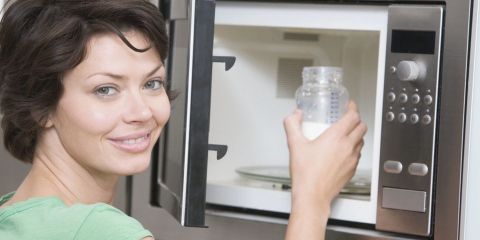Key Points
- Microwaving baby formula can cause heat pockets to form, leading to a real risk of scalding your baby's delicate mouth.
- Baby formula should be heated to body temperature and tested with a few drops on your tongue or the back of your hand.
- Microwaving baby formula does not decrease its nutritional value.
- Heating baby formula on the stove, or heating the water first before adding the formula, are superior methods to microwaving baby formula.
- Glass absorbs heat faster than plastic, leading to a risk of glass baby bottles cracking or shattering when heated. Plastic baby bottles are a safer choice than glass.
Whether you intended to bottle feed your baby from the start or you had planned to breastfeed but had to supplement with or switch to formula feeding, you're not alone. A huge proportion of babies in the United States and around the world are formula-fed. The World Health Organisation found that 60% of babies are bottle-fed within four months of birth.
If your baby is formula-fed, you would know just how time-consuming it can be to prepare, heat, and clean all the bottles your baby needs on a daily basis. When you're stressed, low on sleep, looking after other children, and juggling all your other commitments, you're probably looking for any time-saving tips you can find to prepare your baby's bottles.

Of course, when your baby wakes up hungry - they're hungry now. Breastfed babies have the advantage of being able to feed immediately, whereas formula-fed babies have to wait - usually rather impatiently - for their bottle to be prepared and warmed to the right temperature.
You might event be preparing formula ahead of time storing it in the fridge ensuring that the formula is safe to use to save some additional time.
Is it safe to microwave baby formula? Microwaves heat baby formula unevenly, causing the formula nearest the bottle to feel cool while there may be pockets of dangerously hot formula in the middle of the bottle.
If you're wondering how to heat baby formula in a way that is safe for your baby, read on as we go through all the options.
The Perfect Temperature For Baby
The human body temperature is 98.6 Fahrenheit (37 degrees Celsius), which is the ideal temperature to warm baby formula. Breastmilk is naturally produced at body temperature, making this the natural temperature that babies feel most comfortable with.
Any liquid at room temperature will feel neither hot nor cold on your skin. While it is commonly thought that formula should be tested on the wrist to ensure it is at the correct temperature for your baby, it is now known that the wrist is not a particularly sensitive area of skin to test temperature.
Instead, test a few drops of prepared formula on either your tongue or the back of your hand.

Note that formula should either feel imperceptible on your skin or slightly cool. If the drops feel even slightly warm on your skin, this is a good indication that the formula is too hot for your baby's delicate mouth.
Does Microwaving Baby Formula Decrease Its Nutritional Value?
Extensive testing was undertaken at Pennsylvania State University to answer the question: does microwaving baby formula decrease its nutritional value? Following an exhaustive series of trials, it was found that microwaving baby formula does not reduce its nutritional value.
3 Methods To Safely Heat Baby Formula
Heat On The Stove
Stovetop heating is perhaps the oldest method of baby bottle warming still in use today. In this method, a small amount of water is placed in a saucepan then left to warm on low heat on the stovetop. The water does not need to be brought to the boiling point.
The bottle can either be added to the water at the start and warmed as the water warms, or it can be added to the saucepan after it has been taken off the heat. Either way, the baby formula will reach its perfect temperature within a few minutes.
Heat The Water First
You may be wondering if it's possible to make your baby formula the other way around, i.e. can I heat water in microwave then add formula? Heating water first and then adding the baby formula is an effective method of preparing baby formula, and much preferable to microwaving plastic baby bottles.
As we now know from the above section, there is nothing to suggest that to microwave baby formula reduces its nutritional value. However, there is also no detriment to heating the water first and then adding the powdered formula.
The process of adding the formula and mixing it properly will ensure that any pockets of heat created by microwaving will be evenly dispersed throughout the liquid. This method has the potential advantage of not letting formula go to waste if it is inadvertently overheated.
Hot Running Tap Water
If you're wondering how to heat baby formula when you don't have access to a stove, this method requires nothing more than hot running water. Simply run the hot tap and place the bottle under the running water. It should take only one or two minutes for the formula to reach the desired temperature. Even better, this method involves no risk of the formula heating unevenly or presenting a burning risk to your baby.
Choosing The Right Bottles
When you've made the decision to bottle-feed your baby, it's time to go shopping for baby bottles. But, with an enormous variety of baby bottle brands, types, sizes, and styles available, how can you choose the perfect bottles for your baby? The following tips will help you narrow down your choices:
- While it may be tempting to buy tiny bottles when your baby is an infant and only requires a small amount of formula, your baby will soon require more formula, leaving you to purchase a new set of full-sized bottles. There is nothing wrong with making small amounts of formula in full-sized bottles while your baby is an infant.
- You will need to purchase at least three bottles, each with its own teat, disc, and cap.
- Ensure the bottles you choose are completely smooth on the inside, with no indents or ribbing. This will make the bottles much easier to clean.
- Choose bottles with measurement guides on the outside of the bottle that can be felt with your finger, not just drawn or painted on. With frequent use and washing, painted-on measurement guides will soon wear off, while markings that can be felt under your fingertip will last the lifetime of the bottle.
Next, you'll need to make an important decision between plastic and glass bottles. Consider the following when making your choice.
Plastic Baby Bottles
Microwaving plastic baby bottles poses another serious risk in addition to scalding if the plastic used to construct the bottle is not certified BPA-free.

A report put out by the United States National Institute of Environmental Health Sciences found positive links between BPA exposure and brain and tissue damage , along with increased risks of cancer in later life.
An investigative study undertaken in India found that even low levels of BPA in baby bottles can cause toxic effects in babies and children.
Most bottles available for purchase in the United States are BPA free, however, it is vitally important to check that all plastic baby bottles specifically state that they are "BPA free" or "microwave safe."
Glass Baby Bottles
With the potential dangers associated with plastic baby bottles not marked BPA free, many people wonder whether glass baby bottles are a better alternative. After all, in previous generations glass bottles were the only type of baby bottle available. While glass baby bottles may be harder to source than plastic alternatives, they certainly still exist.
This begs the question; can you microwave glass baby bottles? While it is possible to microwave glass, it is not recommended due to the potential risk of the glass shattering from being heated too rapidly. Glass absorbs energy faster than plastic, and the rapid change in temperature in a microwave can cause the glass to crack or even explode. Plastic is a much safer choice, particularly if you intend to use a microwave to heat formula - even if only occasionally.
By now you understand why it's not a good idea to microwave baby formula, even though it may appear to be a time-saving method for heating baby formula. Unfortunately, microwaving plastic baby bottles introduces the risk of scalding your baby's delicate lips, tongue, and mouth.
Fortunately, there are several other methods for warming baby formula to the perfect temperature that aren't too time-consuming and - most importantly - don't pose any risk to your baby.

